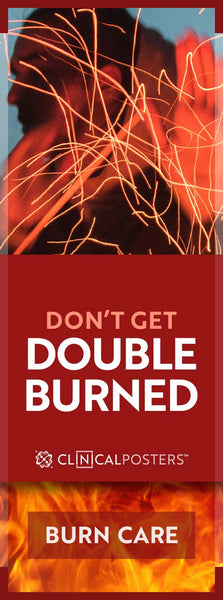Did you know that a suntan is considered a first-degree burn? Skin burn categories are determined not only by depth and tissue damage, but also location and diameter.
« Login For Audio »
Fire Travels Quickly
Burn Care Awareness 1st Week of February
Daily, people scald themselves with hot grease or water in the kitchen or bathroom. You can burn your fingers when grabbing a hot pan from the oven. Various occupations expose workers to sparks, flames or high voltages. With the speed of a spark, a barbecue or flambé accident can thrust you in a position to make important decisions.
Avoid Misguided Solutions
As frequent as skin burns are, it is surprising how many misconceptions there are about how to handle them. Rubbing butter, oil, or mayonnaise on burns or cooling them down with ice cubes are not actions recommended by burn care professionals. (Cocoa butter or aloe may be used after the burn has sufficiently healed to reduce scaring.)

Skin burns compromise our natural thermal layer. Heat from severe burns literally cook an area of flesh. Adding oil increases the dermal temperature, hastening the “cooking” time. A drastic reduction in temperature with a compromised thermal layer can induce hypothermia.
If appropriate action is not taken within the first 20 minutes, a less severe burn can escalate into a more severe one. It is often best to cool, not freeze, the burn while awaiting a fully-equipped ambulance rather than try to drive yourself or a loved one in your own vehicle in an emergency.
Chemical burns are treated differently from thermal burns. Severe injuries are best handled by a regional burn care department rather than a local emergency room. In such cases, a victim might need to be air lifted. An emergency operator can help assess the situation.
Protect Family, Coworkers and Students
Minimize confusion and possible disaster within your home or workplace. Display a poster that outlines appropriate action in different situations. Understanding Skin Burn Severity was prepared in consultation with a regional burn care center director. It can be studied before accidents arise and consulted during an emergency. Hang this helpful poster in trauma centers, restaurant kitchens, schools, automotive shops, industrial plants, and even homes.
Get Out of Burning Building Safely
If you are within a structural fire, there are two enemies to rapidly overcome. First, the fire itself generates hundreds of degrees of heat. The notion of walking through it without a fireproof suit is as logical as climbing into a preheated oven. Second, smoke inhalation is the most common cause of death during house fires. Thick black smoke can cut visibility to inches while irritating eyes.
Both smoke and fire rise so, while moving rapidly towards the nearest exit, stay close to the floor. If possible, cover nose and mouth with cloth to filter smoke. Do not head towards fire. Doors should be closed. They are temporary barriers against fire. Sealing area beneath them with clothing or towels hinders smoke from seeping in if you are forced to barricade in place until help arrives.
If you need to exit a room, remember metal is a conductor of heat. Tap door handle with back of non-dominant hand rather than grasping it with fingers or palm to reduce chance of blistering. If the handle is hot, do not open that door. Ideally, you have an exit route mapped out. If you have a cellphone, call emergency services and seek direction.
Reduce double burn—once from the initial injury and then again by not following proper procedure. Protect yourself from the sunburn by avoiding tanning beds, using SPF 30 or higher sunscreen, and covering up with a wrap when outdoors. The first week of every February is Burn Care Awareness Week. Order your posters today.






